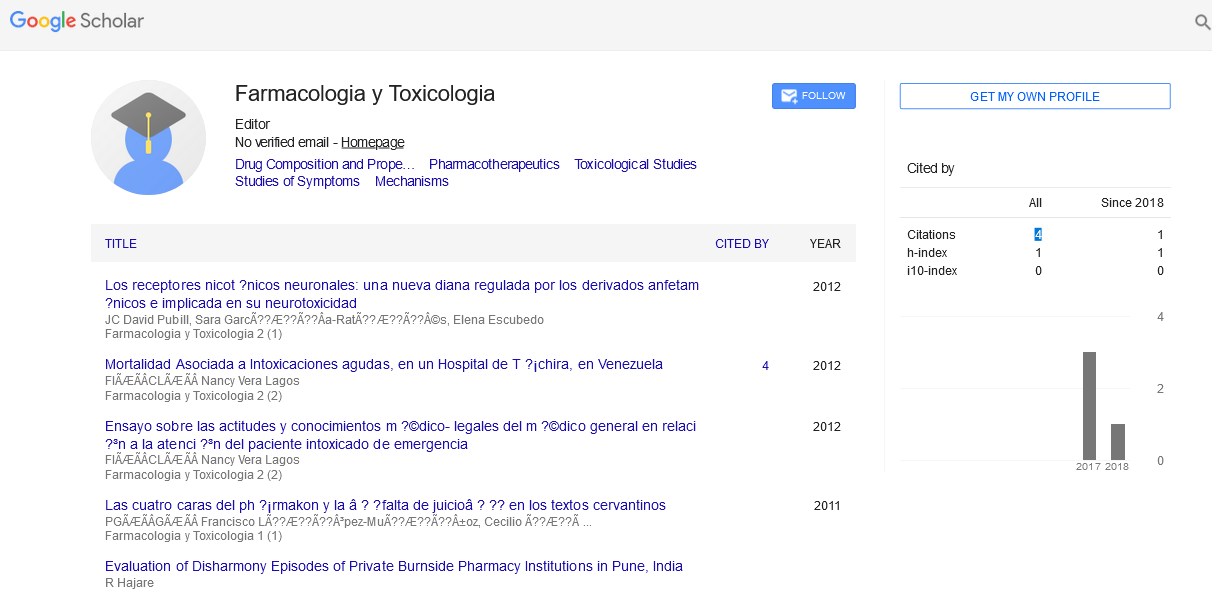Perspective - (2024) Volume 14, Issue 3
Understanding Male Reproductive Toxicology: Impacts, Risks and Insights
Magdalena Valentina*
Department of Toxicology, University of Wansilvania, Brasov, Romania
*Correspondence:
Magdalena Valentina, Department of Toxicology, University of Wansilvania, Brasov,
Romania,
Email:
Received: 04-May-2024, Manuscript No. IPFT-24-14765;
Editor assigned: 08-May-2024, Pre QC No. IPFT-24-14765 (PQ);
Reviewed: 22-May-2024, QC No. IPFT-24-14765;
Revised: 04-Jun-2024, Manuscript No. IPFT-24-14765 (R);
Published:
14-Jun-2024
Introduction
Reproductive toxicology, a vital subset of toxicology, delves
into the effects of various substances on the reproductive
system. While reproductive health encompasses both genders,
male reproductive toxicology focuses on understanding the
impact of toxic substances specifically on the male reproductive
system. The intricate interplay of hormones, genetic factors and
environmental exposures contributes to the complexity of male
reproductive health. In this article, we explore the significance
of male reproductive toxicology, the risks associated with
exposure to toxicants and potential insights gleaned from
research in this field.
Description
The importance of male reproductive toxicology
Male reproductive toxicology is of paramount importance due
to its implications for individual and population health. The
reproductive system plays a crucial role in perpetuating the
species and any disruption to its function can have far-reaching
consequences. Understanding the effects of toxicants on male
reproductive health is essential for identifying potential hazards,
developing appropriate regulatory measures and safeguarding
human fertility.
Furthermore, male reproductive toxicology is relevant beyond
human health. Many wildlife populations are experiencing
declines in reproductive success attributed to environmental
contaminants. By studying the impacts of toxicants on male
fertility in various species, researchers can assess the broader
ecological implications and inform conservation efforts.
Risks associated with exposure to toxicants
Exposure to a myriad of substances in the environment,
workplace and consumer products poses risks to male
reproductive health. These toxicants can interfere with
reproductive processes at multiple levels, including
spermatogenesis, hormone production and sperm function.
Some of the key categories of toxicants affecting male
reproductive health include:
Endocrine disruptors: Endocrine-Disrupting Chemicals (EDCs)
mimic or interfere with the body's hormones, leading to adverse
reproductive outcomes. Substances such as Bisphenol A (BPA), phthalates and organochlorine pesticides have been
implicated in male reproductive toxicity. EDCs can
disrupt hormone signaling pathways, alter sperm quality and
contribute to fertility issues.
Heavy metals: Metals like lead, cadmium and mercury are
known reproductive toxicants with detrimental effects on male
fertility. These metals accumulate in the body over time and can
impair sperm production, motility and viability. Occupational
exposure to heavy metals in industries such as mining,
manufacturing and battery recycling poses significant risks to
male reproductive health.
Lifestyle factors: Certain lifestyle factors, such as smoking,
excessive alcohol consumption and illicit drug use, can adversely
affect male fertility. Tobacco smoke contains numerous toxicants
that damage sperm DNA and impair reproductive function.
Similarly, chronic alcohol abuse can disrupt hormone regulation
and spermatogenesis. Illicit drugs like cocaine and marijuana
have also been linked to decreased sperm quality and infertility.
Environmental pollutants: Environmental pollutants,
including Polychlorinated Biphenyls (PCBs), dioxins and
Polycyclic Aromatic Hydrocarbons (PAHs), can disrupt male
reproductive function. These pollutants often persist in the
environment and accumulate in the food chain, posing risks to
human and wildlife populations. Exposure to air and water
pollutants has been associated with decreased sperm count,
altered hormone levels and reproductive disorders in males.
Insights from male reproductive toxicology research
Research in male reproductive toxicology has provided
valuable insights into the mechanisms of toxicity and potential
interventions to mitigate adverse effects. Some notable findings
and areas of ongoing investigation include:
Epigenetic effects: Epigenetic changes induced by
environmental exposures can influence gene expression patterns
and contribute to reproductive abnormalities. Studies have
revealed alterations in DNA methylation, histone modifications
and non-coding RNA expression associated with male
reproductive toxicity. Understanding these epigenetic
mechanisms may offer new strategies for predicting and
preventing adverse reproductive outcomes.
Developmental Origins of Health and Disease (DOHaD): The DOHaD hypothesis posits that early-life exposures to
environmental factors can predispose individuals to chronic diseases later in life, including reproductive disorders. Research
in male reproductive toxicology has provided evidence
supporting the DOHaD concept, highlighting the importance of
prenatal and early postnatal exposures in shaping reproductive
health outcomes. Identifying critical windows of susceptibility
and implementing interventions during sensitive developmental
periods may help mitigate the long-term impacts of toxicant
exposure on male fertility.
Alternative testing strategies: Traditional animal-based
toxicity testing methods are resource-intensive, time-consuming
and often ethically contentious. In response, researchers are
developing alternative testing strategies, such as in vitro assays
using human cell lines and computational modeling approaches.
These methods offer faster and more cost-effective means of
screening chemicals for reproductive toxicity, accelerating the
identification of hazardous substances and the development of
safer alternatives.
Transgenerational effects: Emerging evidence suggests that
exposure to certain toxicants can induce transgenerational
effects, influencing the health of future generations. Animal
studies have demonstrated transmission of reproductive
abnormalities, epigenetic changes and altered sperm
characteristics to offspring exposed to toxicants in utero or during early development. Investigating the mechanisms
underlying transgenerational effects is critical for understanding
the long-term consequences of environmental exposures on
male reproductive health.
Conclusion
Male reproductive toxicology encompasses a diverse array of
substances and exposures that can detrimentally impact male
fertility and reproductive health. Understanding the risks
associated with exposure to toxicants is essential for
safeguarding male reproductive function and overall well-being.
Ongoing research efforts aimed at elucidating the mechanisms
of toxicity, identifying susceptible populations and developing
alternative testing strategies hold promise for mitigating the
adverse effects of environmental contaminants on male
reproductive health. By integrating findings from male
reproductive toxicology into regulatory frameworks and public
health policies, we can work towards creating environments that
promote reproductive resilience and ensure the vitality of future
generations.
Citation: Valentina M (2024) Understanding Male Reproductive Toxicology: Impacts, Risks and Insights. Farmacologia Toxicologia Vol.14 No.3: 022





